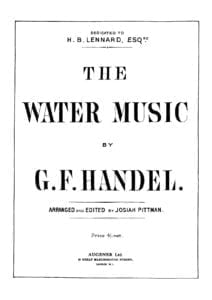Händel – Prelude from Suite No 14 in G Major HWV 441 No 2 Allegro (sheet music, Noten)
Best Sheet Music download from our Library.

Please, subscribe to our Library. Thank you!
This Allegro is taken from a set of Suites for harpsichord published around 1733. Suites were a very common type of music at that time, often using stylised dance forms in a standard order.
This Suite has seven movements (Allemande – Allegro – Courante – Aria – Minuet – Gavotte – Gigue). The Allegro names no dance origin, and resembles a cross between a Courante (which however was in 3-time) and the sort of improvised Prelude that was common in those days based on chords and scale figures.
These preludes dated back to the practice of lutenists who needed to check the sound of different harmonies on their instruments after tuning and before launching into their programme, hence the extended use of arpeggiated chords in this genre.
The texture alternates two-part counterpoint and broken chords. The LH is generally more of an accompaniment than an equal partner, so it should not be overplayed in places such as Bars 6-8 where the effect should be more of an echo.
In Bars 1-4 and similar, where there are tied notes over broken chords, the piano allows for a more singing tone than a harpsichord would, especially if the chords are played quite lightly (imagine how you would play this texture if it were by Schumann).
Tone in performance is likely to be based on a harpsichord sound but it is worth experimenting with other possibilities (such as the Schumann idea above, and touches of pedal) if only to dismiss them.
Tone, touch texture and articulation are very much related in this piece. Listen to the audio for further explanation and demonstration.
For the RH, this piece is an adroit mixture of chord and scale playing, with plenty of ornaments to trip the unwary. Security, control and evenness are essential. Tension can build up in anticipation of ornaments, so they should be practised slowly and in very relaxed fashion.
Finger agility is best achieved by regular use of exercises and warm-ups. A simple warm-up for this piece would be to play scales in broken thirds rather like those in Bar 9.
Remember to look ahead, especially where a RH tied note needs to be held over a chord but is also followed by a higher note – the first note of Bar 1 is the first example of this: the G should be fingered with 4 not 5, to enable the B to be played afterwards. However, there is no need to try and make legato connections after every tied note, as a small break can help give effect to phrasing and provide lightness.
In the descending broken thirds in Bar 9 there are two main possibilities for a pattern to play twice (starting on the A in the second beat): 4 2 3 1 3 1 (4..) or 5 3 4 2 3 1 (5…).
Prior to this the anacrusis and first five semiquavers of Bar 9 could be 1 4 3 2 3 1 3 1 or 2 5 4 3 4 2 3 1. The fingerings involving 5 are closer to what is normally used in scales in “double thirds” to achieve legato but are not strictly necessary here if the student prefers to use stronger fingers.
There are several different ornaments in this piece, all marked for the RH: the first is a simple lower mordant (Bar 3 etc).
At Bar 6 the crotchet A can be trilled from above in demisemiquavers, with or without a turn at the end.
At Bar 10 the trill is a short shake starting on the note above.
A similar ornament is intended on the crotchets in Bars 19-20.
It has long been considered inappropriate to pedal baroque keyboard music played on the piano, since the harpsichord and clavichord had no such possibility.
However, through the 19th and early 20th century nobody saw any harm in using the piano’s full resources on early music. This piece could be used to try to reconstruct such an approach, using a more “pianistic” style, as the broken chords could be given extra warmth by pedalling.
It could be interesting to explore the consequences of this when combined with passages which cannot be pedalled, and discover whether it is possible to construct a convincing modern piano alternative to the current “authentic” (harpsichord-based) norm.
